B0041VYHGW EBOK (105 page)
Authors: David Bordwell,Kristin Thompson

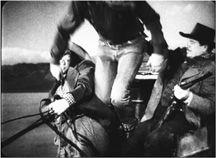
6.100 … and in the next shot both he and the coach are moving leftward.
The continuity system shows that editing can endow the film’s narration with a great range of knowledge. A cut can take us to any point on the correct side of the axis of action. Editing can even create omniscience, that godlike knowledge that some films seek to present. The outstanding technical device here is
crosscutting,
first extensively explored by D. W. Griffith in his last-minute rescue scenes. In
The Battle at Elderbush Gulch,
a cavalry troop is riding to rescue some settlers trapped in a cabin and battling the Indians outside
(
6.101
–
6.104
).
After 11 additional shots of the cavalry, various parts of the cabin interior, and the Indians outdoors, a 12th shot shows the cavalry riding in from the distance behind the cabin.
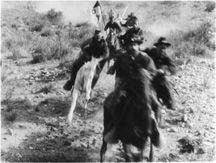
6.101 In
The Battle of Elderbush Gulch,
Griffith cuts from a shot of the cavalry …
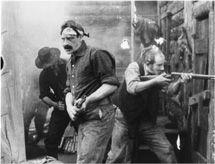
6.102 … to a view inside the besieged cabin …
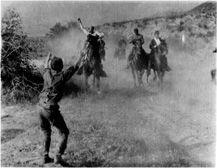
6.103 … back to the cavalry …
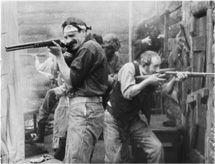
6.104 … and then back to the cabin.
“When we changed the axis of action in the Battle of Gaugamela, if I had kept the light on the left cheek of the Macedonians listening to Alexander’s speech, the actual continuity of light would have been correct. But it would feel different, being frontal light. So for me you have to respect the spirit of the light to maintain the intention of the atmosphere you are trying to convey, instead of ‘real continuity.’”
— Rodrigo Prieto, cinematographer for Oliver Stone’s
Alexander
Crosscutting gives us an unrestricted knowledge of causal, temporal, or spatial information by alternating shots from one line of action in one place with shots of other events in other places. Crosscutting thus creates some spatial discontinuity, but it binds the action together by creating a sense of cause and effect and simultaneous time. In
Jerry Maguire,
for example, crosscutting interweaves the action of sports agent Jerry and his rival racing to sign up the same clients
(
6.105
–
6.108
).
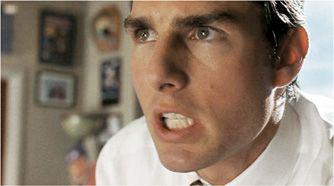
6.105 In
Jerry Maguire,
from a shot of Jerry seething with tension …
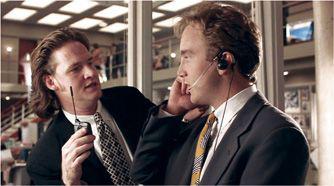
6.106 … there is a cut to his confident rival and his assistant.
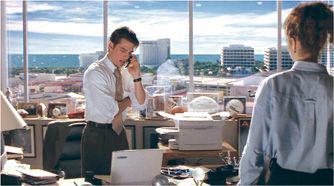
6.107 We cut back to Jerry placing a phone call …
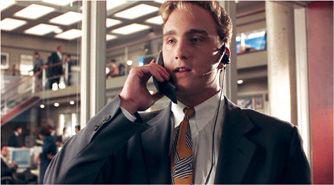
6.108 … and his rival doing the same.
Fritz Lang’s
M
goes further, intercutting three lines of action. While the police seek the child murderer, gangsters prowl the streets looking for him as well, and we also occasionally see the murderer himself. Crosscutting ties together the different lines of action, bringing out a temporal simultaneity and the causal process of the pursuit. The crosscutting also gives us a range of knowledge greater than that of any one character. We know that the gangsters are after the murderer, but the police and the murderer do not. Crosscutting also builds up suspense, as we form expectations that are only gradually clarified and fulfilled. It may create parallels as well, and Lang exploits this possibility by suggesting analogies between the police and the crooks. Whatever other functions it may have, though, crosscutting remains primarily a means of presenting narrative actions that are occurring in several locales at roughly the same time.
All the devices of spatial continuity show how film technique draws the spectator into an active process. We assume that setting, character movement, and character position will be consistent and coherent. Our prior knowledge of filmic conventions lets us form strong expectations about what shot will follow the one we are seeing. We also make inferences on the basis of cues, so that when Brigid and Spade look off left, we infer that someone is entering the room, and we expect to see a shot of that person.
What makes the continuity system invisible is its ability to draw on a range of skills that we have learned so well that they seem automatic. This makes spatial continuity editing a powerful tool for the filmmaker who wishes to reinforce habitual expectations. In recent decades, Hollywood filmmakers have developed ways to make traditional continuity techniques more forceful. (See
“A Closer Look.”
) Because continuity editing has been so widely used for so long, it also becomes a central target for the filmmaker who wants to use film style to challenge or change our normal viewing activities.
In the classical continuity system, time, like space, is organized according to the development of the narrative. We know that the plot’s presentation of the story typically involves manipulation of time. Continuity editing seeks to support and sustain this temporal manipulation.